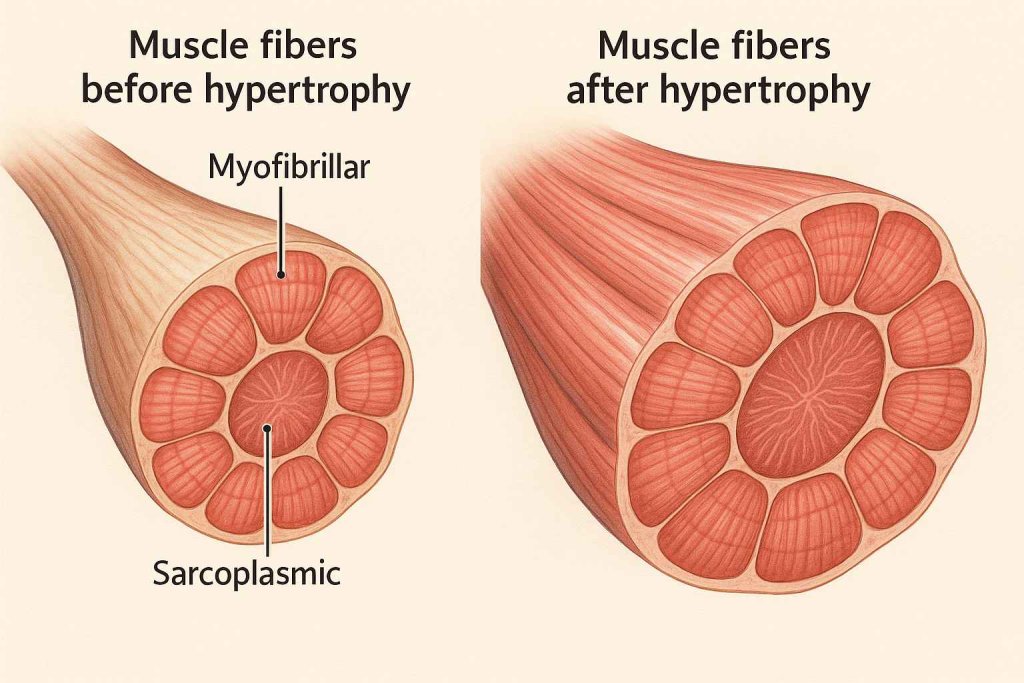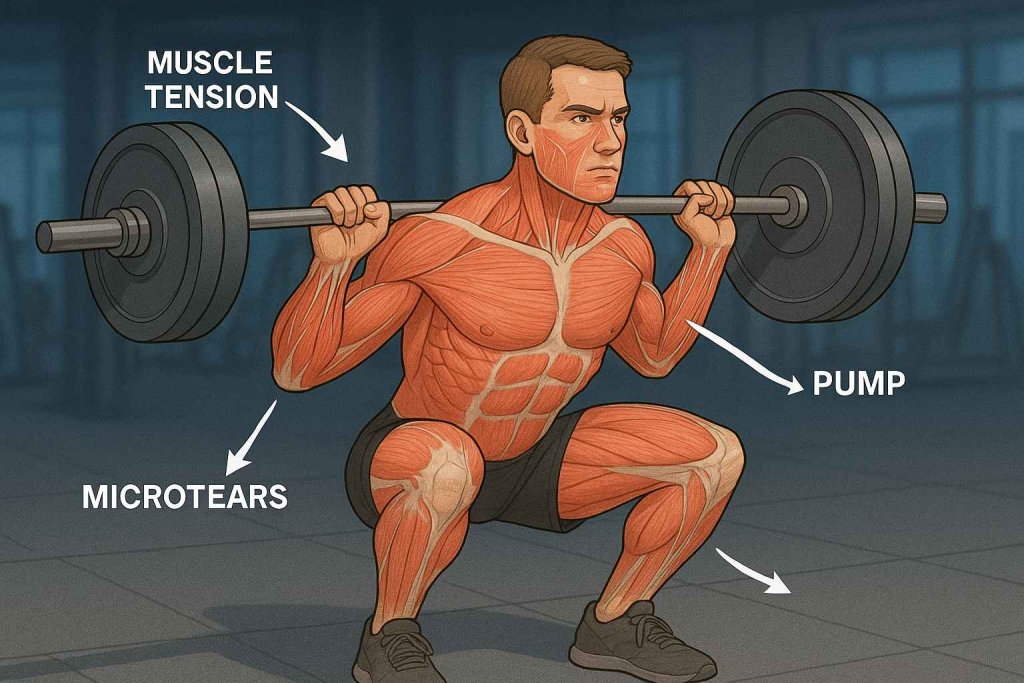Muscle hypertrophy is the process of increasing muscle size through training, especially resistance exercise. In simple terms, if you want bigger and stronger muscles, you need to understand muscle hypertrophy. This is the key process behind all muscle growth, whether your goal is to build a lean physique, enhance strength, or improve sports performance.

Understanding muscle hypertrophy helps you optimize your workouts, avoid common mistakes, and get results faster. This comprehensive guide covers the science, top training strategies, ideal workout frequency, and expert tips so you can build muscle safely and efficiently.
What Is Muscle Hypertrophy?
Muscle hypertrophy refers to the enlargement of muscle fibers in response to consistent strength or resistance training. When you lift weights, your muscle fibers are exposed to tension and stress, which forces them to adapt by becoming larger and stronger.

Types of muscle hypertrophy:
- Myofibrillar hypertrophy: Growth of the actual muscle fibers (myofibrils) responsible for strength and dense muscle. This leads to greater contractile strength.
- Sarcoplasmic hypertrophy: Increase in the fluid and energy stores (sarcoplasm) within the muscle cell. This creates a fuller, pumped appearance and enhances muscular endurance.
Both forms occur together, but training style can influence which one is emphasized. Powerlifters and Olympic lifters often target myofibrillar hypertrophy, while bodybuilders train for both, often prioritizing sarcoplasmic for maximal size.
Learn more: NASM – Sarcoplasmic vs. Myofibrillar Hypertrophy
How Muscle Hypertrophy Happens: Key Mechanisms

Muscle hypertrophy is caused by a combination of mechanical, metabolic, and nutritional factors. Here’s what science says:
- Mechanical Tension: Lifting heavy weights or performing challenging exercises creates tension across muscle fibers. This tension disturbs their structure and forces them to adapt by increasing in size and strength.
- Muscle Damage: Microtears or microscopic damage occur in the muscle fibers during intense exercise, especially during the lowering (eccentric) phase. The body repairs these microtears, making the muscle fibers bigger and more resilient.
- Metabolic Stress: Also known as “the pump,” metabolic stress is the accumulation of metabolites like lactate and hydrogen ions during repeated, intense muscular contractions. This triggers cellular changes and hormonal responses that support hypertrophy.
- Hormonal Response: Resistance training increases the production of hormones like testosterone, growth hormone, and IGF-1, all of which are linked to muscle growth. However, these play a supporting rather than central role.
- Progressive Overload: Regularly increase the demands placed on your muscles—lift heavier, do more reps/sets, or increase workout intensity or complexity over time.
- Nutrition & Protein Intake: Muscle repair and growth require adequate protein (at least 1.6–2.2 g per kg of bodyweight) and total calories. A calorie deficit can slow or halt hypertrophy.
Reference: Brad Schoenfeld, PhD, 2023 – Mechanisms of Muscle Hypertrophy
How to Build Muscle: Step-by-Step, Science-Backed Approach

To maximize muscle hypertrophy, your training should include the following principles:
1. Training Volume and Intensity
- Sets & Reps: Most research supports 3–5 sets per exercise, with 6–20 reps per set for muscle growth.
- Intensity: Use 65–85% of your one-rep max (1RM). Lifting lighter weights to failure can also be effective if effort is high.
- Rest Between Sets: 1–2 minutes for hypertrophy; 2–3 minutes for maximum strength.
2. Exercise Selection
- Compound Exercises: Focus on multi-joint lifts like squats, deadlifts, bench presses, rows, pull-ups, and overhead presses.
- Isolation Exercises: Include movements like bicep curls, triceps extensions, and leg curls to target specific muscles and address weak points.
3. Training Frequency
- Train each major muscle group at least twice per week.
- Split Routine Example: Push/pull/legs, upper/lower body split, or full-body workouts.
4. Progressive Overload
- Gradually increase weight, reps, sets, or exercise difficulty every 2–4 weeks. Progressive overload is essential for ongoing muscle growth.
5. Nutrition
- Protein: Consume 1.6–2.2 grams per kilogram of body weight daily.
- Total Calories: Eat in a slight surplus (about 200–300 calories above maintenance) for optimal muscle growth.
- Carbohydrates & Fats: Ensure a balanced intake to support energy and hormone production.
6. Recovery
- Sleep: Aim for 7–9 hours per night.
- Rest Days: Include at least 1–2 rest days per week to allow muscle recovery.
- Active Recovery: Light activities like walking or stretching can support circulation and healing.
7. Supplementation
- Creatine Monohydrate: Boosts strength and muscle mass, well-researched and safe.
- Whey Protein: Convenient way to hit protein goals.
- Beta-Alanine and HMB: Some evidence for increased endurance and muscle retention, especially in older adults.
Read more: ACSM Hypertrophy Guidelines
How Often Should You Train?
Weekly Training Frequency
- Beginner (0–6 months): 2–3 full-body workouts per week, or upper/lower split.
- Intermediate (6–24 months): 3–5 sessions per week. Push/pull/legs or upper/lower splits, training each muscle group at least twice weekly.
- Advanced (2+ years): 4–6 sessions per week. More specialized splits, still aiming for each muscle group 2x/week for best results.
Science says: A 2019 meta-analysis found training each muscle group twice per week is superior for hypertrophy than once per week (Schoenfeld et al., 2019).
Sample 4-Day Upper/Lower Split
| Day | Workout |
|---|---|
| Monday | Upper Body |
| Tuesday | Lower Body |
| Wednesday | Rest |
| Thursday | Upper Body |
| Friday | Lower Body |
| Saturday | Rest or Cardio |
| Sunday | Rest |
Tips & Suggestions for Faster Muscle Growth
- Log Your Progress: Use a workout journal or app to track lifts, sets, reps, and rest.
- Prioritize Compound Lifts: 70–80% of your exercises should be compound for optimal gains.
- Slow Down the Eccentric: Lower weights slowly (2–4 seconds), as research shows this increases muscle damage and growth.
- Don’t Skip Recovery: Chronic soreness or fatigue is a sign of overtraining. Take scheduled rest days and deload weeks every 6–8 weeks.
- Nutrition Timing: While overall protein intake is more important than timing, distributing protein evenly across 3–4 meals can enhance muscle protein synthesis.
- Don’t Fear Carbs: Carbohydrates support intense training and recovery.
- Hydrate Well: Dehydration can limit both strength and recovery.
- Use Full Range of Motion: Partial reps limit results. Move through the full range for each exercise.
- Try Creatine: Creatine monohydrate is proven to boost muscle and strength gains for most people (Examine.com).
How Fast Can You Build Muscle? (Timelines & Realistic Expectations)
Expected Rates of Muscle Gain
- Beginners (first year): 1–2 lbs (0.5–1 kg) per month, depending on genetics, effort, and nutrition.
- Intermediates (1–2 years): 0.5–1 lb (0.25–0.5 kg) per month.
- Advanced (2+ years): 0.25–0.5 lb (0.1–0.25 kg) per month.
Note: Muscle gain is slower in women, older adults, and those with advanced training experience.
Tip: Building muscle takes time—consistency and patience are your best friends!
Safety, Injury Prevention & Overtraining
- Warm Up: Always start with 5–10 minutes of light cardio and dynamic stretches to prepare muscles and joints.
- Cool Down: End with static stretching and light activity to support recovery.
- Perfect Your Form: Use correct technique to avoid injury—don’t ego-lift.
- Deload Weeks: Every 6–8 weeks, reduce training volume or intensity to allow full recovery.
- Listen to Your Body: Persistent pain (not soreness) is a warning sign—rest and consult a professional if needed.
- Stay Hydrated: Aim for 3–4 liters of water per day, especially if you sweat a lot.
Frequently Asked Questions
Do I need to train to failure for hypertrophy?
No. Training close to failure (1–3 reps left in the tank) is usually sufficient for muscle growth and safer for joints.
Is muscle soreness a sign of effective training?
Not always. Soreness isn’t a requirement for hypertrophy and can indicate excessive damage or insufficient recovery.
Do I need supplements?
Supplements aren’t necessary but can help. Creatine, whey protein, and beta-alanine have the best evidence. Always focus on diet first.
How important is sleep for muscle growth?
Critical! Poor sleep reduces growth hormone, testosterone, and recovery—aim for 7–9 hours nightly.
Can I build muscle without a gym?
Yes! Bodyweight training and resistance bands can stimulate hypertrophy, especially for beginners or those training at home.
Conclusion
Muscle hypertrophy is achievable for anyone who trains consistently, eats properly, and applies evidence-based principles. Train every muscle group at least twice a week, push yourself with progressive overload, focus on recovery, and be patient.
